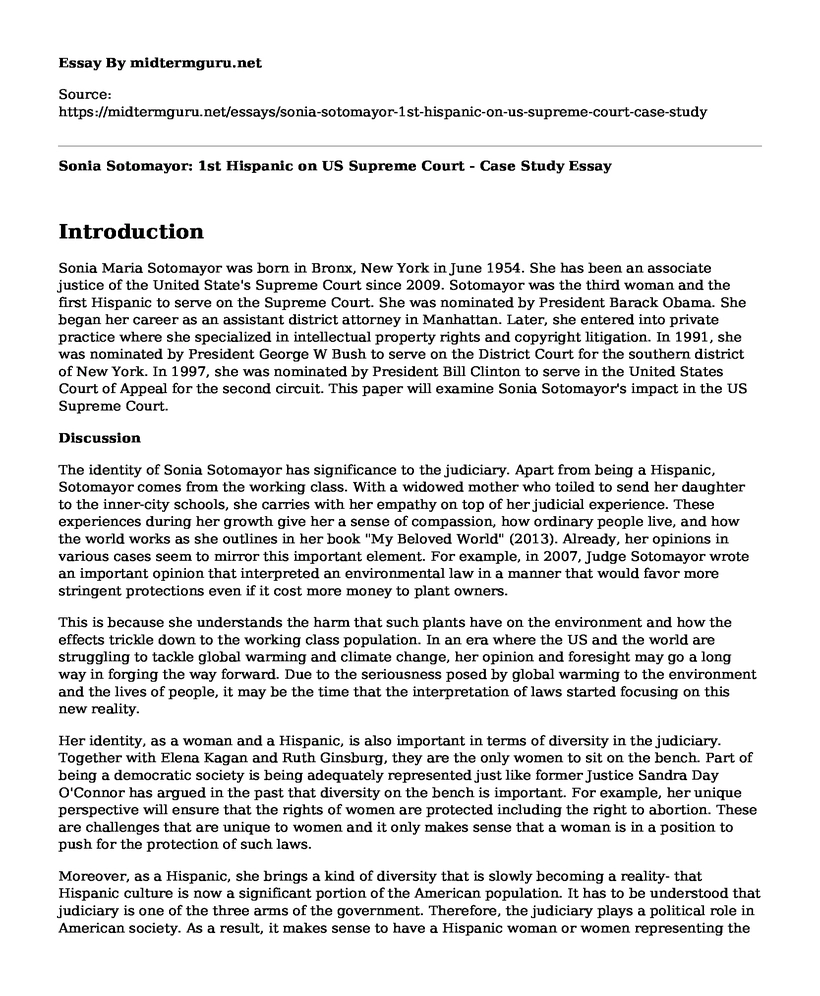Introduction
Sonia Maria Sotomayor was born in Bronx, New York in June 1954. She has been an associate justice of the United State's Supreme Court since 2009. Sotomayor was the third woman and the first Hispanic to serve on the Supreme Court. She was nominated by President Barack Obama. She began her career as an assistant district attorney in Manhattan. Later, she entered into private practice where she specialized in intellectual property rights and copyright litigation. In 1991, she was nominated by President George W Bush to serve on the District Court for the southern district of New York. In 1997, she was nominated by President Bill Clinton to serve in the United States Court of Appeal for the second circuit. This paper will examine Sonia Sotomayor's impact in the US Supreme Court.
Discussion
The identity of Sonia Sotomayor has significance to the judiciary. Apart from being a Hispanic, Sotomayor comes from the working class. With a widowed mother who toiled to send her daughter to the inner-city schools, she carries with her empathy on top of her judicial experience. These experiences during her growth give her a sense of compassion, how ordinary people live, and how the world works as she outlines in her book "My Beloved World" (2013). Already, her opinions in various cases seem to mirror this important element. For example, in 2007, Judge Sotomayor wrote an important opinion that interpreted an environmental law in a manner that would favor more stringent protections even if it cost more money to plant owners.
This is because she understands the harm that such plants have on the environment and how the effects trickle down to the working class population. In an era where the US and the world are struggling to tackle global warming and climate change, her opinion and foresight may go a long way in forging the way forward. Due to the seriousness posed by global warming to the environment and the lives of people, it may be the time that the interpretation of laws started focusing on this new reality.
Her identity, as a woman and a Hispanic, is also important in terms of diversity in the judiciary. Together with Elena Kagan and Ruth Ginsburg, they are the only women to sit on the bench. Part of being a democratic society is being adequately represented just like former Justice Sandra Day O'Connor has argued in the past that diversity on the bench is important. For example, her unique perspective will ensure that the rights of women are protected including the right to abortion. These are challenges that are unique to women and it only makes sense that a woman is in a position to push for the protection of such laws.
Moreover, as a Hispanic, she brings a kind of diversity that is slowly becoming a reality- that Hispanic culture is now a significant portion of the American population. It has to be understood that judiciary is one of the three arms of the government. Therefore, the judiciary plays a political role in American society. As a result, it makes sense to have a Hispanic woman or women representing the Hispanic demographic in one of the arms of the government.
As highlighted by the 2009 case named Ricci v. Destefano Sotomayor holds liberal views that are essential for a forward-looking society even if such views might be labeled as affirmative action. In this case, white and Hispanic firefighters claimed discrimination when the city of New Haven threw out the results of a test for promotional exams where black firefighters had scored poorly. Her decision in the case was widely criticized on the basis that she supported the courts four liberal judges. She was criticized for not being radical enough or thinking outside the box.
The opponents to her views on the case argued that she is a liberal who is likely to agree with the liberal justices in the most closely divided cases on the basis of ideology. The race-based effects of the testing have a heavy bearing of race and this reflects the manner of which issues of race are likely to keep coming up in the Judiciary. The issue of race is important in the US as minority groups are now becoming a significant voice in serious matters including employment and consequent discrimination in employment. By asserting her voice in this important issue, it signifies that Judge Sotomayor is not afraid to give her opinion to an issue that is rapidly evolving for the Supreme Court and to the country at large.
Conclusion
As observed, Justice Sotomayor has had a significant impact on the bench as well as what her identity means for the judiciary. As revealed, as a woman, she is a representative for the women and stands as a safeguard to some of the rights that are unique to the women. In addition, Judge Sotomayor background as a Hispanic from the working class brings the empathy and understanding that is needed in the judiciary is tackling some of the contemporary challenges that are unique to the demographic.
Reference
Sotomayor, S. (2013). My beloved world. New York: Alfred A. Knopf.
Cite this page
Sonia Sotomayor: 1st Hispanic on US Supreme Court - Case Study. (2023, Jan 12). Retrieved from https://midtermguru.com/essays/sonia-sotomayor-1st-hispanic-on-us-supreme-court-case-study
If you are the original author of this essay and no longer wish to have it published on the midtermguru.com website, please click below to request its removal:
- Essay Example: The Fourteenth Amendment
- Essay Sample on Impacts of World War II to United States Homefront
- Essay Sample on Equity, Justice and Human Dignity
- Essay Sample on Abraham Lincoln as a Reflection of Culture and the Time He Existed
- Research Paper on Mexican-American War
- Savannah PD: Securing Order Through Funding & Partnerships - Essay Sample
- Learning US History: From Gilded Age to Present Day - Essay Sample







